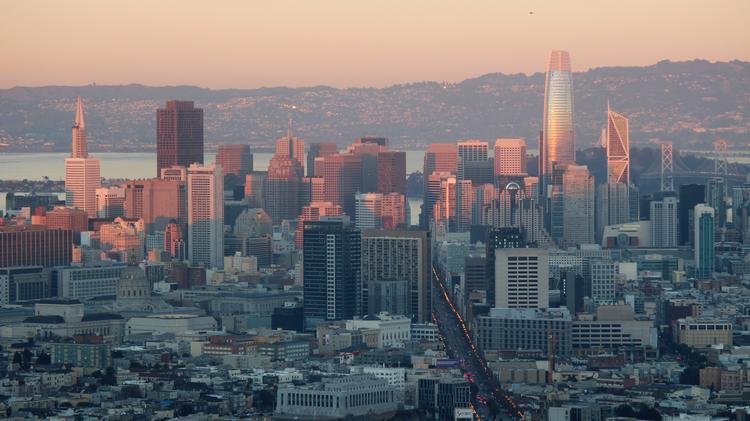
Multifamily rents still haven’t reached pre-pandemic levels in the Bay Area’s two biggest cities. That could soon change
Rents commanded by large multifamily properties in San Francisco and San Jose have lagged behind much of the rest of the country in their post-pandemic recovery, data from brokerage firm CBRE shows. That could soon change.
San Francisco and San Jose were the only two markets of nearly 70 nationwide analyzed by CBRE in which average rent for such properties had not either reached or exceeded pre-Covid levels by the first quarter of this year, according to data released by the firm earlier this month. Using data from property management software RealPage, CBRE analyzed 67,197 units across 404 institutional-grade buildings, most with 50 or more units, in San Francisco, and 111,341 units across 563 such buildings in San Jose.
In San Francisco, average rents remain 10.2% below pre-pandemic highs; in San Jose, 6.2%. Average rents in the two cities for the first quarter of this year were $3,134.83 and $2,833.79, respectively.
It’s not that the two Bay Area markets haven’t seen substantive recovery since the onset of the pandemic more than two years ago: San Francisco and San Jose posted 13.3% and 14.1% year-over-year rent growth in the first quarter of this year, CBRE’s data shows. That the two cities still haven’t yet recovered pre-pandemic rents is a reflection of just how hard they were hit by the pandemic, according to Matthew Vance, who helms multifamily research for CBRE.
“Dense, urban centers were most negatively impacted by and during the pandemic,” Vance said. Markets that suffered the most tended to be denser, more mature and coastal. Still, a number of other markets studied by CBRE — including Oakland, Los Angeles, New York City and Boston — also fit that description, and have seen rents rebound to pre-pandemic levels.
Vance attributes the lag to the high concentration of tech workers in San Francisco and San Jose. Much of that workforce has been given the opportunity to work completely remotely — some of them on a permanent basis, he pointed out. The finance and legal sectors have been quicker to bring their workers back into the office, boosting demand in markets like New York City, where those industries tend to have more of a presence.
CBRE Executive Vice President Jefrey Henderson, who co-founded the firm’s Silicon Valley multifamily and office investment group, said Thursday he believes San Francisco and San Jose are at something of a turning point.
Henderson is beginning to hear from hiring managers at area tech firms who are only considering candidates willing to relocate to the Bay Area, he said. Others are asking employees who have moved out of the area to take cost-of-living adjustments – in other words, salary cuts. Both phenomena could incentivize workers to return here.
Some high-profile area tech firms have begun their returns to the office, though Apple this week pushed back a plan to have employees return three days a week starting May 23 amid rising Covid case rates and hospitalizations nationwide. San Francisco and San Jose have slipped back to the bottom two places among the nation’s 10 largest metro areas in the percentage of pre-pandemic office workforces who have returned to working on site, building security firm Kastle reported after briefly moving up the table.
Return-to-office aside, there are other encouraging signs in the two markets, Vance said. Vacancy rates for multifamily properties in both cities have dipped below pre-pandemic levels: as of the first quarter, San Francisco is at 3.6%, compared to 4.2% pre-crisis, and San Jose is at 2.9%, compared to 4%, CBRE’s data shows.
“By many metrics, the market has recovered, and rent is the last piece of the puzzle that is gaining momentum,” Vance told me.
He says it’s poised to do so quickly. Increases in demand for multifamily units in the two cities will drive vacancies even lower in coming quarters, Vance thinks, and as both markets remain supply constrained — San Francisco infamously so — that’ll put upward pressure on rents. Vance says CBRE is projecting year-over-year rent growth in both markets to reach more than 15% next quarter. That puts both on track to recover pre–pandemic rents in the second half of this year, and the growth won’t stop there.
“We expect (the Bay Area) to maintain double-digit growth, above the national average, through the end of this year, and even into the beginning of next year, before it begins falling into the high-single digits,” Vance said of year-over-year jumps.
That would put rent growth in the region ahead of the national average, Vance said. Burgeoning markets like Austin and Salt Lake City will stave off those kind of spikes thanks to the delivery of “dramatic” new supply of units — as much as 6% or 7% of existing stock — expected over the next few years, he said.
Full article by Sarah Klearman: http://bizjournals.com/sanfrancisco/news/2022/05/20/san-francisco-jose-multifamily-rent-covid.html

